Top Content Distribution Platform Strategies for 2025
Discover the best content distribution platform to boost your reach and maximize engagement in 2025. Explore top tools now!
Posted by
Reach New Heights: Unleashing the Power of Content Distribution
Creating great content isn't enough. You need to share it effectively. Struggling to reach your target audience? This listicle presents 10 top-tier content distribution platforms to amplify your message and maximize your reach. Discover tools like EndorseFlow, ContentKing, Outbrain, and more. We'll break down the pros and cons of each platform—from social media scheduling (Hootsuite, Buffer, Sprout Social, Later) to email marketing (Mailchimp) and paid content promotion (Taboola, Outbrain)—helping you choose the perfect content distribution platform for your 2025 needs.
1. EndorseFlow
EndorseFlow positions itself as a cutting-edge content distribution platform, but it's much more than just that. It's a comprehensive solution designed to streamline the entire process of gathering, leveraging, and distributing authentic customer testimonials, particularly through video, to amplify your social media presence and boost conversions. It effectively bridges the gap between customer feedback and content marketing, offering a centralized hub for managing everything from testimonial collection to multi-platform social media scheduling. In a world where authenticity and social proof reign supreme, EndorseFlow offers a powerful way to harness the voice of your customers and transform it into engaging content that resonates with your target audience. This makes it a particularly valuable tool for small business owners, digital marketers, social media managers, customer success teams, and creative agencies seeking to strengthen their brand credibility and drive tangible results.
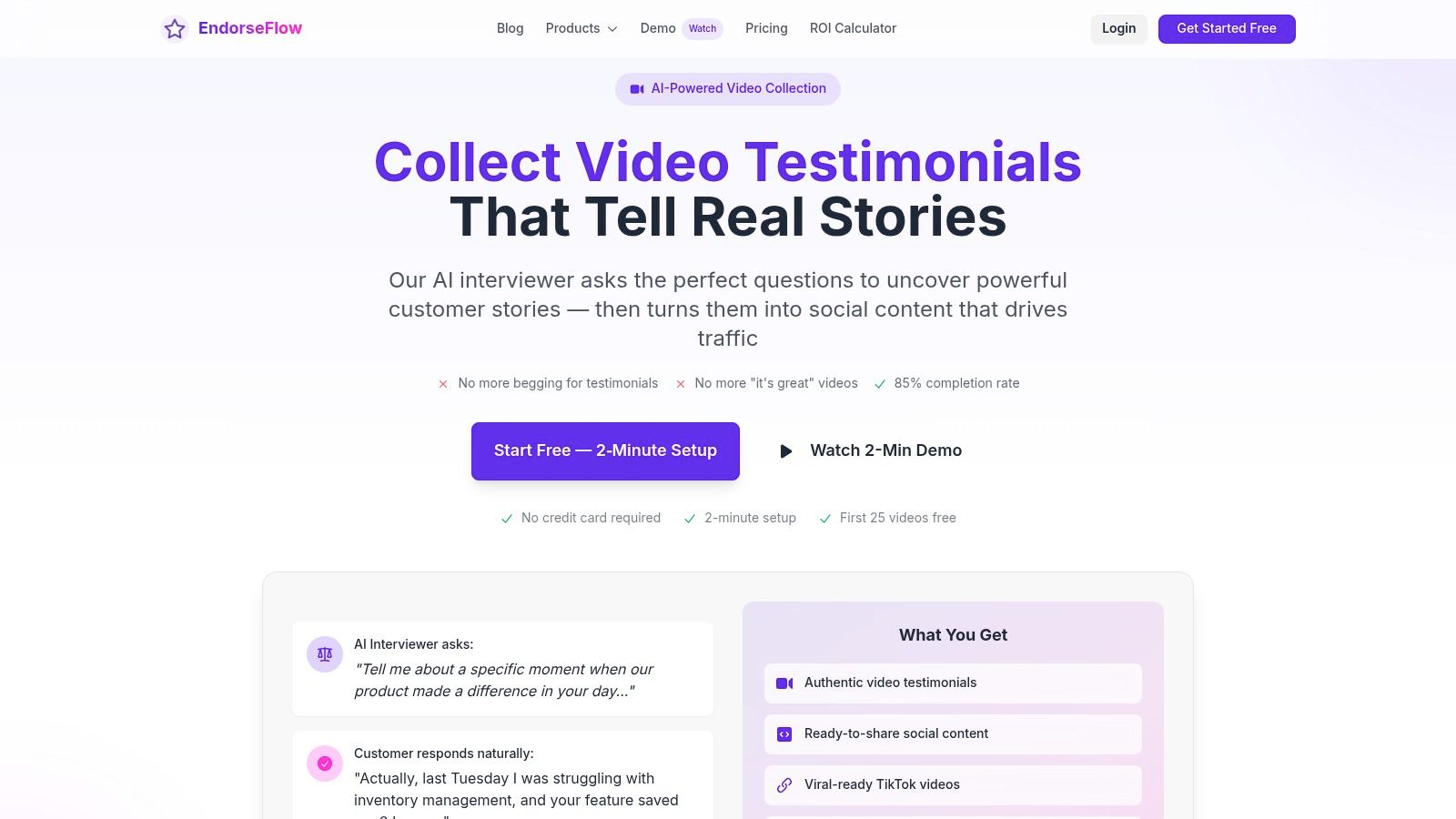
One of EndorseFlow’s core strengths lies in its AI-powered video testimonial collection process. Moving beyond traditional text-based feedback, EndorseFlow facilitates engaging, interview-style video recordings that capture rich, specific customer stories. This approach results in an impressive 85% completion rate, far surpassing the engagement levels of typical survey methods. These video testimonials are then automatically optimized and formatted for various social media platforms, transforming raw customer feedback into viral-ready TikTok videos, Instagram Reels, and other engaging content formats. This automated process significantly reduces the time and effort required to create high-performing social media content, allowing you to focus on strategy and other core business functions. Further streamlining your workflow, EndorseFlow offers a unified social media scheduler enabling cross-posting across major platforms like Facebook, Instagram, Twitter/X, LinkedIn, Pinterest, and TikTok – all managed from a single, intuitive dashboard.
EndorseFlow stands out from other content distribution platforms by tightly integrating testimonial collection, content creation, and social media management. While other tools might offer scheduling or content generation capabilities, few provide such a seamless end-to-end solution for leveraging customer voices. This integration is particularly beneficial for businesses seeking to build strong social proof, as it simplifies the process of turning customer satisfaction into shareable content that resonates with potential buyers.
From a technical standpoint, EndorseFlow requires no specialized software or hardware. It's a cloud-based platform accessible through a web browser, making it convenient for teams working remotely or across multiple locations. Furthermore, its integration with Zapier opens up a world of automation possibilities, connecting EndorseFlow to over 3,000 apps and streamlining various marketing and operational tasks. This allows you to connect EndorseFlow to your CRM, email marketing platform, and other essential tools, creating a cohesive and efficient marketing ecosystem. Learn more about EndorseFlow and the advantages of a cohesive cross-posting strategy.
Pricing plans are designed to be flexible and cater to a range of business sizes. A free tier is available with no credit card required, providing a risk-free opportunity to explore the platform's core functionality. Paid plans offer additional features like unlimited video duration, higher team member limits, and advanced analytics. While the premium tiers might be an investment for very small businesses, the ROI calculator provided by EndorseFlow helps quantify the potential time and revenue savings, allowing businesses to make informed decisions based on their specific needs and budget.
While EndorseFlow offers a robust and integrated solution, there are a few considerations. Some advanced features, like unlimited video duration and larger team member allowances, are reserved for the higher-tier plans, which might be a limiting factor for some smaller businesses. Also, if you already rely heavily on specialized social media management or testimonial collection tools, integrating EndorseFlow might add another layer to your existing workflow. However, for businesses seeking a streamlined, all-in-one solution for leveraging customer voices and amplifying their social media presence, the benefits of EndorseFlow’s integrated approach likely outweigh these potential drawbacks. The platform’s ease of use, combined with its ability to uncover authentic customer stories and transform them into engaging content, makes it a compelling choice for businesses looking to build trust, drive conversions, and maintain a consistent and vibrant online presence.
2. ContentKing
ContentKing stands out as a powerful content distribution platform, albeit one with a primary focus on SEO optimization and monitoring. While not solely dedicated to content distribution in the same vein as some social media management platforms, its real-time auditing and monitoring capabilities provide businesses with the tools to optimize their content’s reach and impact across their web properties. This ensures content is not only distributed effectively but is also discoverable and performs well in search engine results, a crucial element of any content distribution strategy. It achieves this by offering continuous website monitoring, tracking content performance, and delivering actionable SEO insights. For businesses prioritizing organic search visibility as a primary distribution channel, ContentKing provides invaluable support.
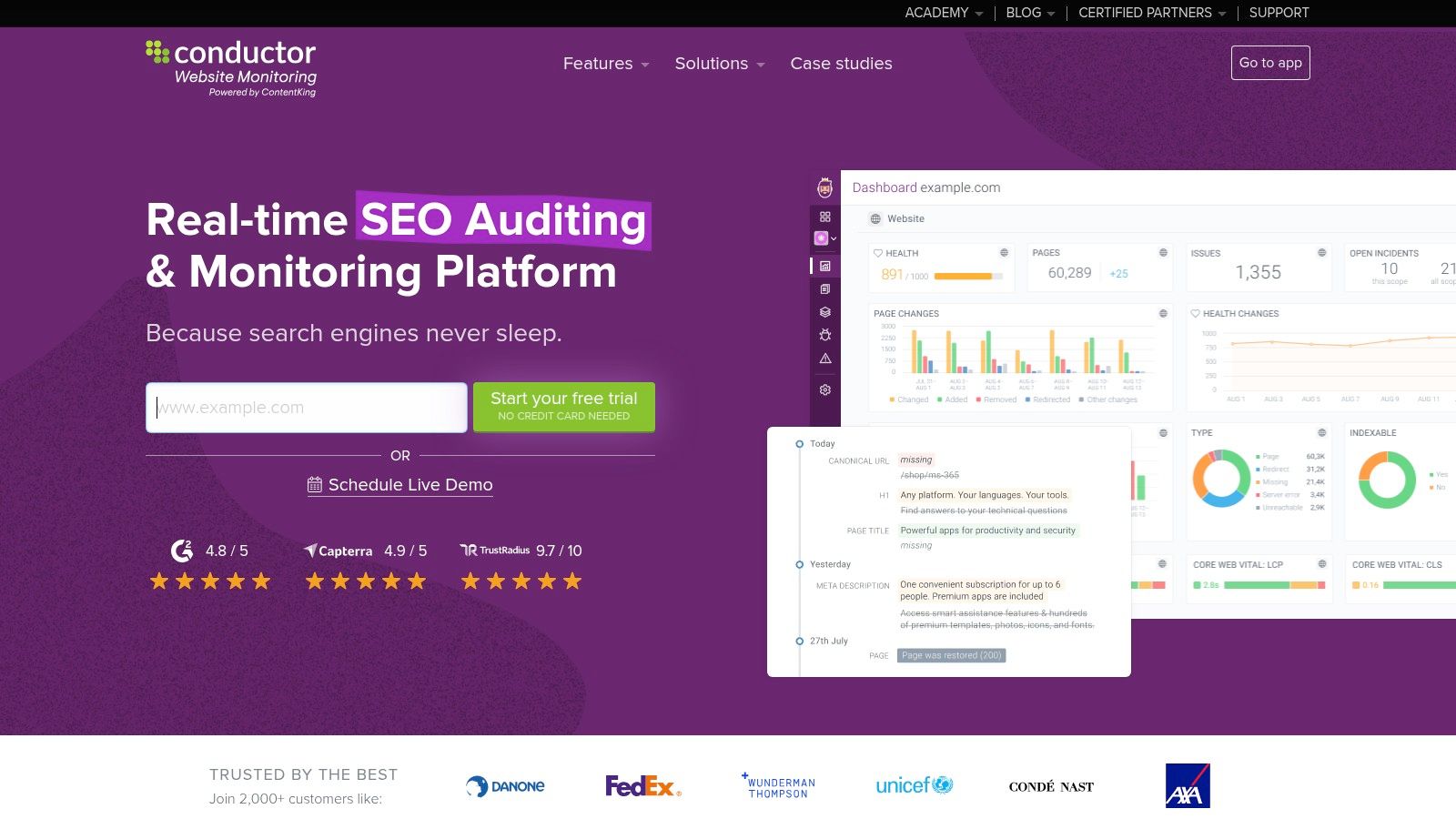
Imagine this: you’ve just published a crucial piece of content, a cornerstone of your latest campaign. Within minutes, ContentKing alerts you to a broken link within the article, preventing search engines from properly indexing it and potentially impacting your ranking. This real-time monitoring capability is a game-changer for businesses seeking to maintain a flawless online presence and ensure their content distribution efforts aren’t hampered by technical issues. Beyond just identifying problems, ContentKing also tracks content changes and analyzes their impact on SEO performance. Did a recent update to a landing page improve its keyword ranking? ContentKing will tell you. This allows for data-driven optimization, refining your content distribution strategy based on tangible results.
ContentKing offers a robust suite of features tailored for businesses of all sizes. These include real-time SEO monitoring and alerts, which notify you instantly of any issues impacting your website’s performance, from broken links and 404 errors to sudden drops in rankings. The platform’s content change tracking and analysis feature allows you to monitor modifications made to your website's content, ensuring consistency and identifying the impact of updates on SEO performance. For a deeper dive into technical aspects, ContentKing provides comprehensive technical SEO auditing tools, uncovering hidden technical issues that could be hindering your website’s visibility. Managing multiple websites becomes streamlined with the multi-site management dashboard, providing a centralized hub for overseeing the SEO health and content performance across your entire web portfolio. Finally, the API integration facilitates automated workflows, connecting ContentKing with other marketing tools for seamless data exchange and enhanced efficiency.
ContentKing’s strengths lie in its proactive approach to SEO. Instant notifications of SEO issues allow you to address problems swiftly, minimizing any potential negative impact. The platform's comprehensive technical SEO coverage provides a thorough analysis of your website's technical health, leaving no stone unturned. The user-friendly interface presents actionable insights in a clear and concise manner, empowering even non-technical users to understand and address SEO challenges. Moreover, ContentKing is known for its excellent customer support, providing timely assistance and guidance when needed.
While ContentKing offers a powerful solution for content distribution via SEO optimization, it does have some limitations. The platform's pricing is higher compared to some competitors, which might be a barrier for smaller businesses or those with limited budgets. Its extensive features can be overwhelming for beginners, requiring a learning curve to fully utilize its potential. Furthermore, ContentKing's focus is primarily on SEO auditing and monitoring, meaning it lacks robust content creation features. If you’re looking for a platform to help you actually write and design your content, you’ll need to supplement ContentKing with other tools.
For businesses serious about leveraging organic search as a primary content distribution channel, ContentKing justifies its place on this list. Its real-time monitoring and comprehensive analysis empower you to ensure your content is not only discoverable but also performing optimally. However, its pricing and complexity might make it less suitable for beginners or those with limited resources. For a more in-depth understanding of the platform and its pricing structure, visit their website at https://www.contentkingapp.com.
Setting up ContentKing involves creating an account and adding your website(s). The platform will then automatically crawl your sites and begin monitoring for SEO issues and content changes. Tailoring the alert settings to your specific needs is crucial to avoid notification overload. Focus on critical issues initially and gradually expand the scope of monitoring as you become more familiar with the platform. Integrating ContentKing with other marketing tools via the API can further enhance your workflow efficiency, automating data exchange and streamlining your content distribution efforts.
3. Outbrain
Outbrain is a prominent player in the content distribution platform landscape, specializing in native advertising and content discovery. It offers a powerful solution for businesses and publishers looking to expand their content's reach and engage with a broader audience across a network of premium websites. Outbrain leverages sophisticated machine learning algorithms to match content with readers who are most likely to be interested, thereby driving targeted traffic and boosting engagement through personalized recommendations. This makes it a valuable tool for content marketers seeking to increase brand visibility and drive conversions.
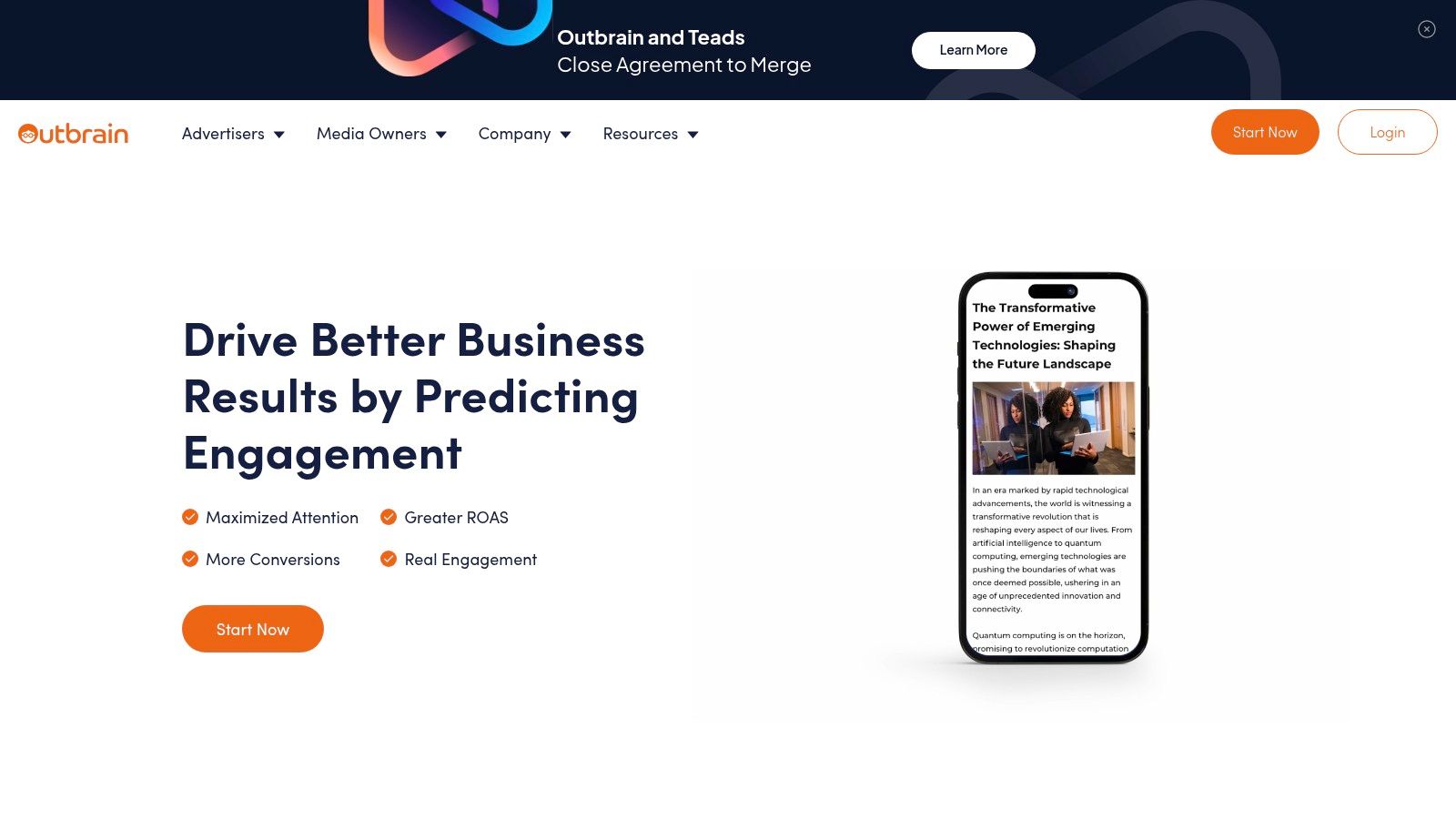
Outbrain distinguishes itself within the content distribution platform ecosystem through its focus on native advertising. Unlike traditional display ads, native ads seamlessly blend into the surrounding content, providing a less intrusive and more engaging experience for readers. This approach allows businesses to reach potential customers in a contextually relevant environment, increasing the likelihood of clicks and conversions. For publishers, Outbrain offers a way to monetize their content by displaying sponsored recommendations that align with their audience's interests.
One of Outbrain's key strengths lies in its advanced audience targeting and segmentation capabilities. Digital marketers can refine their campaigns based on demographics, interests, browsing behavior, and even contextual keywords, ensuring that their content reaches the most relevant audience segments. This granular control helps maximize the impact of content distribution efforts and improves the return on investment. The platform's real-time analytics and performance tracking tools offer valuable insights into campaign performance, allowing marketers to monitor key metrics like clicks, impressions, and conversions, and make data-driven adjustments to optimize their strategies.
For businesses operating across multiple devices, Outbrain provides cross-device campaign management, ensuring consistent messaging and branding across desktops, tablets, and smartphones. This feature is crucial in today's multi-device world, allowing marketers to reach their target audience wherever they consume content. The platform's ability to amplify content across a vast network of premium publishers significantly expands its potential reach. Outbrain partners with leading news sites, blogs, and online magazines, giving businesses access to a highly engaged audience.
While Outbrain offers significant advantages as a content distribution platform, it's important to consider its potential drawbacks. One notable concern is the cost, which can be prohibitive for small businesses with limited marketing budgets. The platform typically operates on a cost-per-click (CPC) model, and the competitive bidding landscape can drive up prices, especially for popular keywords and target audiences. While Outbrain doesn’t publicly list its pricing, sources indicate a minimum budget requirement, often starting around $10,000 per month. It’s recommended to contact Outbrain directly for specific pricing details based on your campaign needs. Furthermore, achieving optimal results with Outbrain requires ongoing optimization and monitoring. Marketers need to actively manage their campaigns, test different targeting options, and refine their creative assets to maximize performance.
Compared to other content distribution platforms like Taboola, Outbrain is often considered to offer access to a higher quality publisher network, focusing on more established and reputable websites. While Taboola may offer a more budget-friendly option for smaller businesses, Outbrain’s emphasis on premium publishers can translate to better brand safety and potentially higher engagement rates.
Implementing Outbrain involves creating an account, setting up campaigns, defining target audiences, and uploading content assets. It's recommended to start with a well-defined content strategy and clear campaign objectives. Leveraging Outbrain's targeting options effectively is key to reaching the desired audience and maximizing ROI. Regularly monitoring campaign performance and making data-driven adjustments is crucial for optimizing results. While there aren't strict technical requirements beyond access to a computer and internet connection, a solid understanding of digital marketing principles and performance tracking is essential for successful Outbrain campaign management.
In conclusion, Outbrain is a powerful content distribution platform that offers significant advantages for businesses and publishers seeking to expand their reach and engage with targeted audiences. Its focus on native advertising, advanced targeting capabilities, and access to premium publishers makes it a valuable tool for driving website traffic and increasing brand visibility. However, the cost and the need for ongoing optimization should be carefully considered, especially by smaller businesses.
4. Taboola
Taboola is a prominent content distribution platform specializing in native advertising and content recommendations. Leveraging artificial intelligence, Taboola partners with publishers to display sponsored content seamlessly integrated within their websites. This approach allows brands to reach a wider audience and drive engagement through content that aligns with user interests, while simultaneously offering publishers a robust monetization avenue. Taboola's strength lies in its ability to connect brands with relevant audiences at scale, making it a valuable tool for content distribution. Its focus on native advertising ensures that sponsored content feels less intrusive and more organic to the user experience, leading to higher click-through rates and improved brand perception. This makes it a powerful content distribution platform for businesses seeking to expand their reach and engage target audiences effectively.
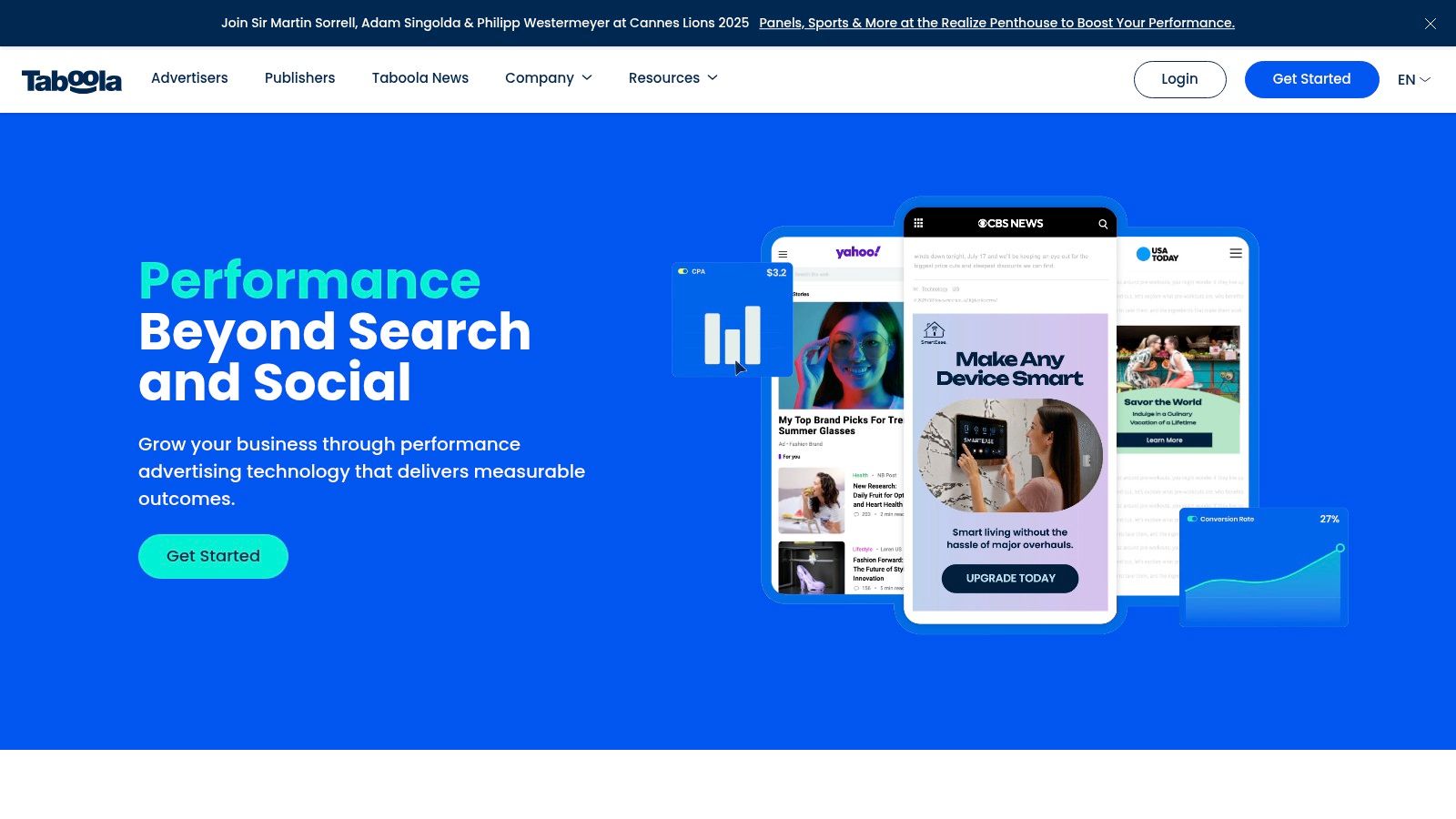
For small business owners, digital marketers, social media managers, customer success teams, and creative agencies, Taboola offers a sophisticated suite of tools to enhance content visibility and drive measurable results. Its AI-powered recommendation engine analyzes user behavior to personalize content suggestions, ensuring that the right content reaches the right audience. This personalized approach maximizes engagement and drives conversions, making Taboola a cost-effective content distribution platform.
Features and Benefits:
- AI-Powered Content Recommendations: Taboola's core strength resides in its sophisticated AI, which analyzes user data to deliver highly personalized content recommendations. This ensures content relevance and maximizes engagement potential.
- Native Advertising Solutions: Taboola seamlessly integrates sponsored content within the publisher's website, ensuring a non-disruptive user experience. This native format increases user receptiveness to advertised content, leading to higher click-through rates.
- Publisher Monetization Tools: For publishers, Taboola offers a lucrative revenue stream through native advertising placements. The platform provides tools to manage ad inventory, track performance, and optimize earnings.
- Advanced Targeting and Personalization: Taboola offers granular targeting options based on demographics, interests, and browsing behavior, enabling precise audience segmentation and personalized content delivery.
- Cross-Platform Campaign Management: Manage and monitor campaigns across multiple publisher websites from a centralized dashboard. This streamlines workflow and provides a holistic view of campaign performance.
Practical Applications and Use Cases:
- Driving Traffic to Product Pages: Use Taboola to promote specific product pages and drive targeted traffic to your website.
- Increasing Brand Awareness: Leverage Taboola's vast publisher network to expand your brand's reach and increase visibility among a broader audience.
- Lead Generation: Create engaging content that captures leads and nurtures prospects through the sales funnel.
- Content Amplification: Extend the reach of your existing content by distributing it across Taboola's network of premium publishers.
- Retargeting Website Visitors: Re-engage users who have previously interacted with your website to encourage conversions.
Comparison with Similar Tools:
Taboola is often compared to Outbrain, another leading native advertising platform. Both platforms offer similar features and functionalities, but Taboola is generally considered to have a larger network of premium publishers, potentially offering broader reach. Outbrain, on the other hand, is sometimes perceived as having a slightly stronger focus on content quality control. The choice between the two often depends on specific campaign goals and budget considerations.
Implementation and Setup Tips:
- Define Clear Objectives: Before starting a Taboola campaign, clearly define your goals, whether it's driving traffic, generating leads, or increasing brand awareness.
- Target Audience Segmentation: Utilize Taboola's advanced targeting options to precisely define your target audience based on demographics, interests, and browsing behavior.
- Create Compelling Content: The success of your Taboola campaign hinges on the quality and relevance of your content. Invest in creating engaging and informative content that resonates with your target audience.
- A/B Testing: Experiment with different ad creatives and targeting parameters to optimize campaign performance and maximize ROI.
- Monitor and Analyze Results: Regularly monitor your campaign performance using Taboola's reporting and analytics tools. Use the insights to refine your strategy and improve results over time.
Pricing and Technical Requirements:
Taboola operates on a cost-per-click (CPC) model, and typically has minimum spend requirements which can be relatively high, often starting in the thousands of dollars per month. The specific pricing varies depending on factors like targeting, industry, and campaign objectives. Technical requirements are minimal, primarily involving creating an account and setting up campaigns through Taboola's user-friendly interface.
Pros and Cons:
Pros:
- Large network of premium publishers
- Sophisticated AI recommendation engine
- Strong monetization opportunities for publishers
- Comprehensive reporting and analytics
Cons:
- High minimum spend requirements
- Can be complex to set up initially
- Quality control challenges with some placements
- Limited control over ad placement context
Website: https://www.taboola.com
In conclusion, Taboola stands as a powerful content distribution platform for businesses aiming to leverage the potential of native advertising. Its sophisticated AI, vast publisher network, and comprehensive targeting options make it a valuable tool for reaching target audiences and driving meaningful results. While the platform does have some drawbacks, particularly the high minimum spend, its strengths in content personalization and distribution make it a compelling option for those looking to scale their content marketing efforts.
5. CoSchedule
CoSchedule positions itself as an all-in-one marketing platform, moving beyond a simple content distribution platform to encompass the entire content lifecycle. This makes it a powerful option for businesses looking to streamline their content operations from planning and creation to distribution and analysis. Its strength lies in unifying all these processes, offering a centralized hub for teams to manage their entire content strategy. This integrated approach helps break down silos between different marketing functions, fostering better collaboration and a more cohesive content strategy. If you're looking for a content distribution platform that offers robust project management and team collaboration features, alongside scheduling capabilities, CoSchedule is definitely worth considering.
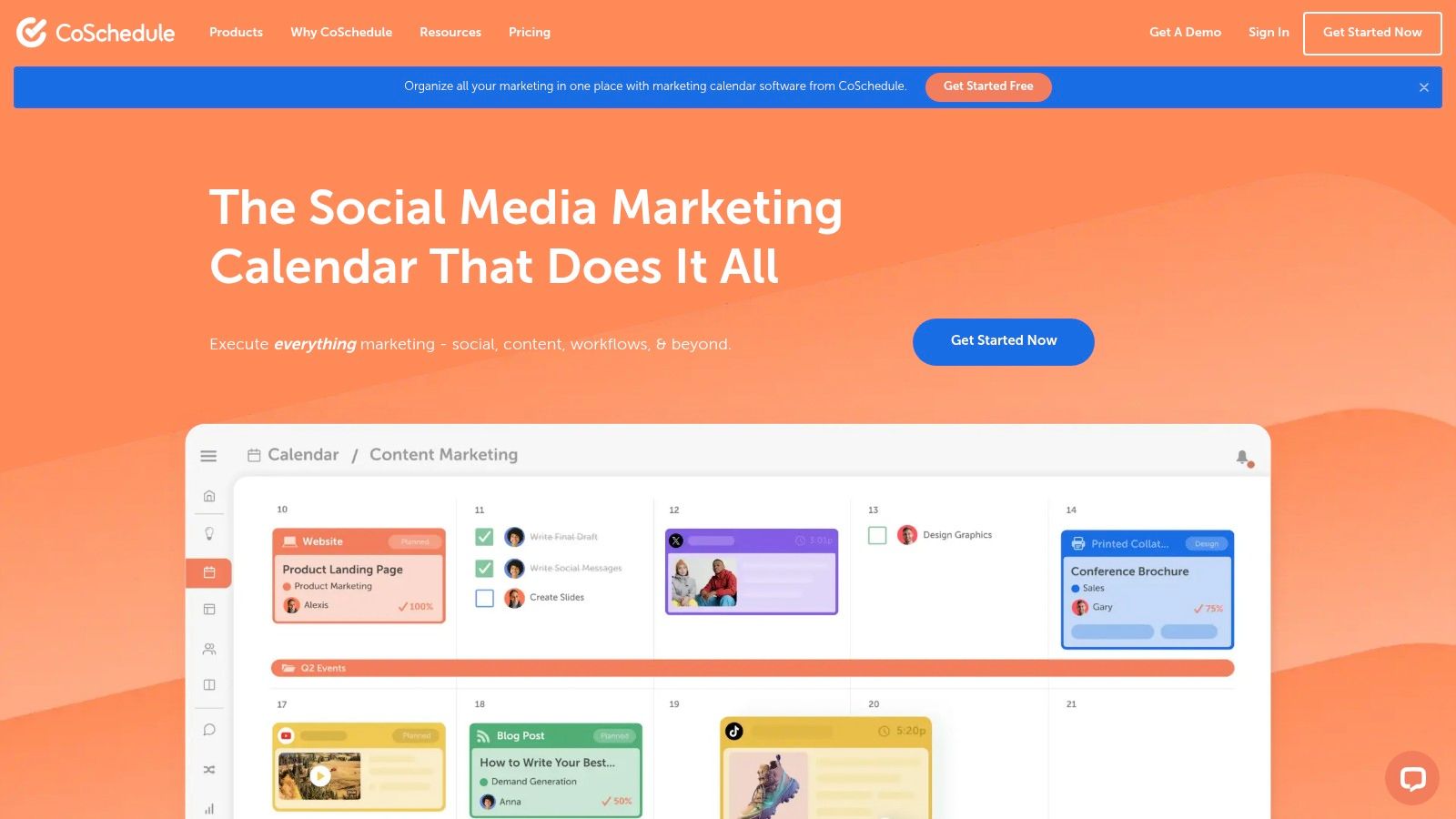
CoSchedule shines in its ability to facilitate a smooth and efficient content workflow. Imagine managing a complex blog post rollout involving multiple team members: writers, editors, designers, and social media managers. CoSchedule's content workflow and collaboration tools allow you to assign tasks, set deadlines, track progress, and share feedback all within a single platform. This eliminates the need for endless email chains and fragmented communication, drastically improving team efficiency and reducing the risk of errors or delays. The unified marketing calendar provides a clear overview of all scheduled content, ensuring consistent publishing and avoiding conflicts.
For social media managers, CoSchedule offers scheduling and publishing features, enabling you to plan and automate your social media posts across various platforms. While it may not offer the granular control and advanced features of dedicated social media management tools like Buffer or Hootsuite, it provides a sufficient solution for basic social media scheduling and integrates seamlessly with the overall content calendar. This is particularly beneficial for coordinating social media promotion with other content initiatives.
One of CoSchedule's standout features is its robust project management capabilities. The platform allows you to manage entire marketing campaigns, from initial ideation to final reporting, all within the same interface. This is a significant advantage over simpler content distribution platforms that focus solely on scheduling. For marketing teams juggling multiple projects simultaneously, CoSchedule's project management features offer much-needed organization and control.
While CoSchedule offers numerous advantages, it's important to be aware of its limitations. The pricing can be a significant hurdle for smaller teams or startups with limited budgets. While they offer different pricing tiers, unlocking the full potential of the platform requires a higher-tier subscription. Furthermore, mastering the more advanced features of CoSchedule can involve a learning curve. The intuitive drag-and-drop interface makes basic tasks easy to pick up, but utilizing the full range of functionalities may require some dedicated training.
Compared to simpler content distribution platforms like Buffer or Hootsuite, CoSchedule offers a more comprehensive solution. While Buffer and Hootsuite excel at social media management, CoSchedule takes a broader approach, incorporating content planning, creation, and project management into the mix. If your needs extend beyond social media scheduling and you're looking for a centralized platform to manage your entire content operation, then CoSchedule is a strong contender.
Implementing CoSchedule typically involves integrating it with your existing marketing tools. CoSchedule offers a wide range of integrations with popular platforms like WordPress, Google Analytics, and Mailchimp. This allows you to seamlessly connect your existing workflows with CoSchedule, maximizing efficiency and minimizing disruption. During the initial setup, it's crucial to clearly define user roles and permissions, ensuring each team member has access to the appropriate tools and resources.
CoSchedule's pricing varies depending on the chosen plan and the number of users. Contact their sales team for detailed pricing information. Technical requirements are minimal, as the platform is cloud-based and accessible through a web browser. No specialized software installation is required.
In conclusion, CoSchedule earns its spot on this list by offering a powerful and comprehensive content distribution platform that goes beyond simple scheduling. Its integrated approach to content planning, creation, distribution, and analysis makes it a valuable tool for businesses looking to streamline their marketing operations and improve team collaboration. While the pricing and learning curve may be considerations, the benefits of a unified marketing platform can outweigh these drawbacks for teams seeking a centralized solution for their content needs. If you're ready to take your content strategy to the next level, exploring CoSchedule's offerings is a worthwhile investment. Visit their website at https://coschedule.com for more information and to request a demo.
6. Hootsuite
Hootsuite is a robust content distribution platform designed to streamline social media management. It empowers businesses, particularly small business owners, digital marketers, social media managers, customer success teams, and creative agencies, to effectively distribute content across various social networks from a centralized dashboard. This eliminates the need to log into individual platforms, saving valuable time and effort. Hootsuite's comprehensive suite of tools allows users to schedule posts, monitor conversations, analyze performance, and collaborate with team members, all contributing to a more efficient and effective social media strategy. Its prominent position as a leading content distribution platform stems from its ability to simplify the complexities of multi-platform social media management and empower users to maximize their content's reach and impact.
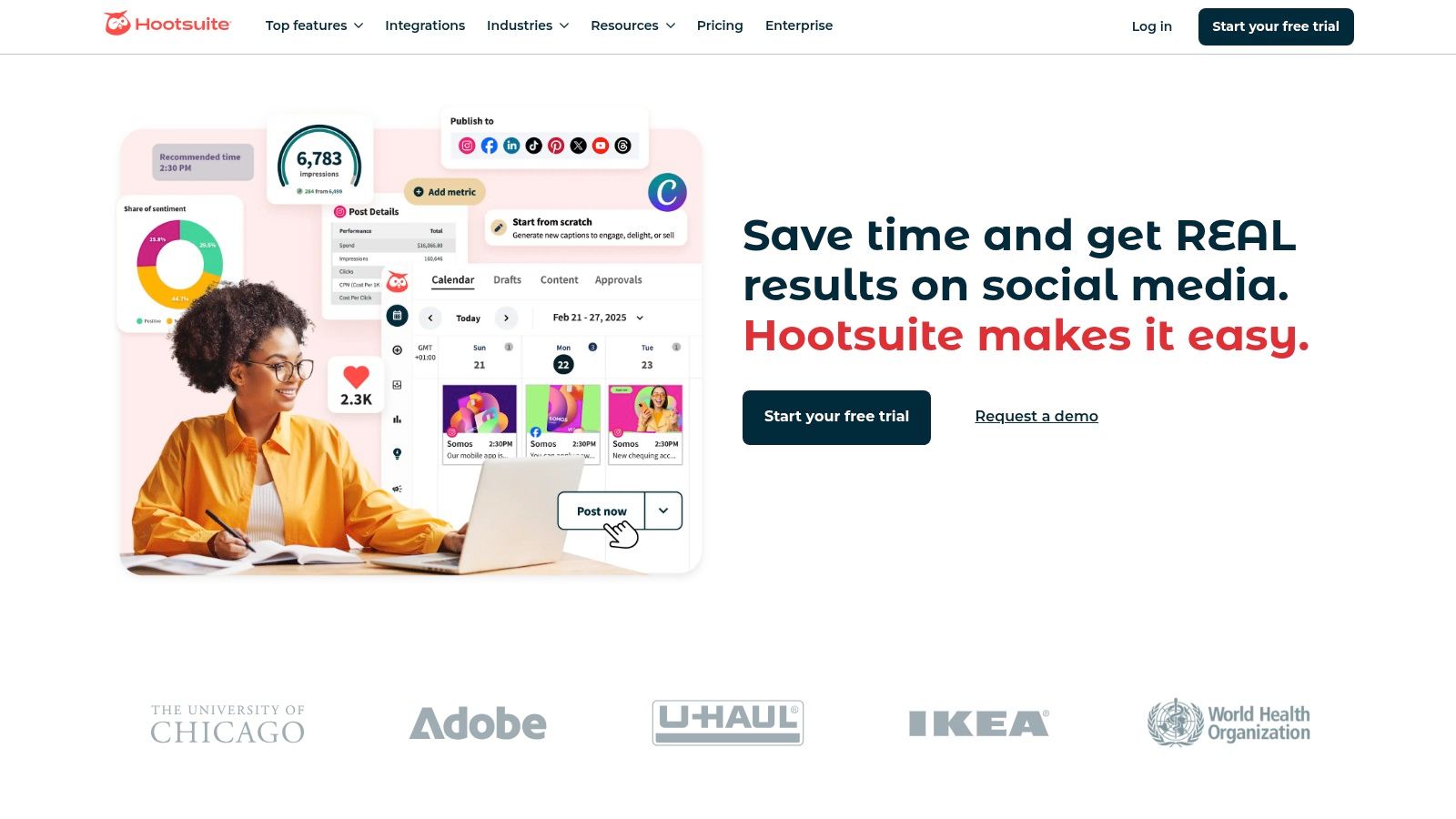
Hootsuite's core strength lies in its multi-platform scheduling capabilities. Users can schedule posts across a wide range of social media platforms, including Facebook, Instagram, Twitter, LinkedIn, Pinterest, and YouTube. This feature is a game-changer for busy professionals who need to maintain a consistent online presence without being tethered to their computers. Imagine a small business owner preparing a week's worth of social media content in one sitting, scheduling it to go out at optimal times, and then focusing on other aspects of their business. Hootsuite makes this a reality.
Beyond scheduling, Hootsuite offers robust social listening and monitoring tools. These tools allow users to track brand mentions, industry keywords, and competitor activity. This real-time insight enables businesses to stay informed about conversations relevant to their brand and participate in a timely and relevant manner. For example, a customer success team can use Hootsuite to monitor social media for customer feedback and address issues promptly, enhancing customer satisfaction and building brand loyalty.
Team collaboration is another area where Hootsuite excels. The platform provides features for assigning tasks, approving workflows, and sharing feedback within teams. This streamlines the content creation and approval process, particularly beneficial for creative agencies and marketing teams working on multiple campaigns simultaneously. Imagine a marketing team collaborating on a new product launch campaign; Hootsuite allows them to seamlessly manage content creation, review, and approval workflows, ensuring a cohesive and consistent message across all social media channels.
Hootsuite’s comprehensive analytics and reporting tools empower users to track key metrics, measure campaign performance, and gain valuable insights into audience engagement. These data-driven insights are essential for refining social media strategies and maximizing ROI. For example, a digital marketer can use Hootsuite's analytics to identify which types of content resonate most with their target audience and adjust their content strategy accordingly.
Furthermore, Hootsuite offers content curation features and RSS feed integration, allowing users to discover and share relevant third-party content with their followers. This helps businesses position themselves as thought leaders and keep their social media feeds fresh and engaging.
While Hootsuite offers a powerful suite of tools, it does have some drawbacks. The interface, particularly for new users, can feel cluttered and overwhelming. Some advanced features, such as unlimited social profiles and advanced analytics, are only available on higher-tier plans. While Hootsuite does allow for basic image editing, its video editing capabilities are limited. Finally, customer support response times can vary, which can be frustrating for users requiring immediate assistance.
Hootsuite offers several pricing plans ranging from a free plan for individual users to enterprise-level solutions for large organizations. The paid plans offer varying levels of functionality, such as the number of social profiles that can be managed, team member access, and advanced analytics features. Technical requirements are minimal; Hootsuite is a cloud-based platform accessible through a web browser or mobile app.
Compared to other social media management tools like Buffer and SproutSocial, Hootsuite offers a broader range of features and integrations, making it a suitable choice for businesses looking for a comprehensive solution. However, Buffer's simplicity might be preferred by users seeking a more streamlined experience, while SproutSocial's focus on social listening and analytics could be more appealing to businesses prioritizing those aspects.
For implementing Hootsuite, start by connecting your social media accounts and setting up your profile. Then, explore the platform's features, such as scheduling, monitoring, and analytics. Consider starting with a free plan to familiarize yourself with the platform before upgrading to a paid plan for advanced features.
In conclusion, Hootsuite is a valuable content distribution platform that empowers businesses to manage their social media presence effectively. Despite some minor drawbacks, its comprehensive features, multi-platform support, and robust analytics make it a powerful tool for anyone seeking to enhance their social media strategy and achieve tangible results. You can explore Hootsuite further by visiting their website: https://hootsuite.com.
7. Buffer: A Streamlined Content Distribution Platform for Effortless Social Media Management
Buffer secures its spot on this list of top content distribution platforms thanks to its user-friendly approach to social media management. It shines as a powerful yet accessible tool, simplifying the often overwhelming process of scheduling, publishing, and analyzing content across various social media channels. This makes it a particularly attractive option for small businesses, individual creators, and those new to the complexities of social media marketing. As a content distribution platform, Buffer prioritizes ease of use and efficiency, allowing users to maintain a consistent online presence without getting bogged down in complicated workflows.
Buffer's core strength lies in its intuitive interface. The clean, visual layout simplifies content scheduling, providing a clear overview of planned posts across connected platforms. Forget wrestling with complex dashboards; Buffer makes scheduling posts as straightforward as composing an email. You can easily drag and drop posts to rearrange your schedule, preview how they will look on different platforms, and even customize posting times for optimal engagement. This visual content calendar provides a bird's-eye view of your social media strategy, ensuring a consistent brand presence across all channels. Learn more about Buffer. This blog post delves deeper into how a social media scheduler can revolutionize your content strategy, and Buffer is a prime example of a tool that effectively fulfills this role.
Beyond scheduling, Buffer functions as a robust publishing platform, allowing you to distribute content directly to platforms like Facebook, Instagram, Twitter, LinkedIn, and Pinterest. This multi-platform approach eliminates the need to log into each account individually, saving valuable time and streamlining your workflow. Imagine managing all your social media content from a single, unified hub – that's the power Buffer offers. This centralized content distribution streamlines the entire process, enabling you to focus on crafting engaging content rather than juggling multiple logins and platforms.
Furthermore, Buffer doesn't stop at scheduling and publishing. It provides valuable performance analytics and insights, allowing you to track the effectiveness of your content strategy. Monitor key metrics such as reach, engagement, and click-through rates to understand what resonates with your audience and refine your approach accordingly. While the basic reporting features in lower-tier plans are admittedly limited, the higher-tier plans unlock more comprehensive analytics, offering a deeper understanding of your social media performance.
For teams working collaboratively on social media management, Buffer provides helpful features for team collaboration and permission management. Assign roles, control access levels, and facilitate seamless workflows for content approval and publishing. This is particularly beneficial for agencies managing multiple client accounts or businesses with dedicated social media teams.
While Buffer excels in its user-friendliness and affordability, it's essential to acknowledge some limitations. Compared to more advanced content distribution platforms like SproutSocial or Hootsuite, Buffer offers fewer features for social listening and in-depth competitive analysis. The bulk scheduling options are also somewhat restricted. If your primary focus is detailed social listening and advanced analytics, you might find Buffer's capabilities lacking. However, for the vast majority of small businesses and individual creators, these limitations are often outweighed by Buffer's ease of use and affordable pricing.
Speaking of pricing, Buffer offers a variety of plans catering to different needs and budgets. From free plans for individual users to more comprehensive plans for businesses, there’s a tier that fits most scenarios. Technical requirements are minimal, requiring only a web browser or the mobile app for access. Setup is remarkably simple – connect your social media accounts, customize your posting schedule, and start sharing your content.
In summary, Buffer stands out as a valuable content distribution platform due to its user-friendly design, streamlined workflow, and multi-platform publishing capabilities. While it may lack some of the advanced features found in competitor platforms, its simplicity and affordability make it an ideal choice for those seeking a straightforward and effective solution for managing their social media presence. If you're a small business owner, digital marketer, or individual creator looking for an intuitive content distribution platform, Buffer is definitely worth considering. It's a powerful tool that simplifies social media management, allowing you to focus on what truly matters: creating and sharing engaging content with your audience.
8. Sprout Social
Sprout Social stands out as a robust content distribution platform, particularly suited for enterprise-level businesses and agencies. It goes beyond simple scheduling and publishing by offering a comprehensive suite of tools that encompass content distribution, customer engagement, and social listening, all within a single, unified platform. This makes it a powerful solution for organizations looking to streamline their social media management and maximize their impact. While Sprout Social can be a valuable asset for scaling businesses, its comprehensive nature might feel overwhelming for smaller businesses or individuals with limited social media needs.
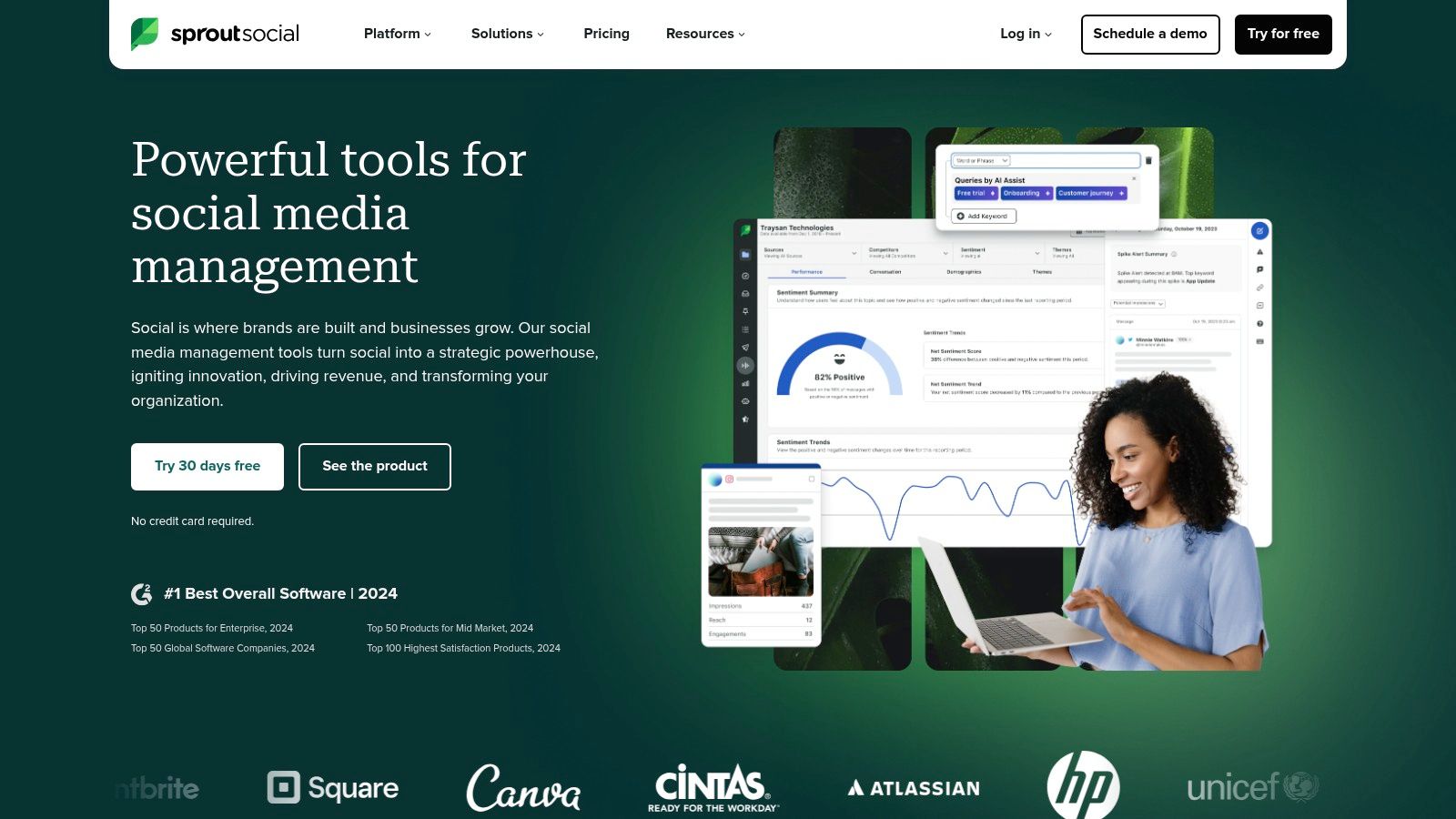
One of Sprout Social's core strengths lies in its advanced analytics and reporting capabilities. Beyond basic metrics like likes and shares, Sprout Social provides in-depth insights into audience demographics, content performance, and campaign effectiveness. These insights empower users to refine their content strategy, identify trends, and understand what resonates with their target audience. For example, marketers can track the performance of individual posts across different platforms, identifying high-performing content and optimizing future campaigns based on data-driven decisions. These analytics also extend to competitor analysis, allowing users to benchmark their performance against industry rivals and identify opportunities to gain a competitive edge.
Furthermore, Sprout Social excels in social CRM and customer engagement. It provides tools to manage customer interactions, track conversations, and respond to inquiries efficiently. This streamlined approach helps businesses build stronger relationships with their audience and foster brand loyalty. For instance, customer success teams can use Sprout Social to monitor brand mentions and respond to customer queries or complaints promptly and professionally, ensuring a positive customer experience. This centralized platform also facilitates team collaboration, with features like approval workflows and shared content calendars ensuring consistent messaging and efficient task management. This is particularly valuable for larger teams or agencies managing multiple clients.
Sprout Social also offers robust social listening capabilities. By monitoring keywords, hashtags, and brand mentions, businesses can gain valuable insights into industry trends, customer sentiment, and competitor activity. This intelligence can inform product development, marketing campaigns, and overall business strategy. For example, a business might use social listening to identify emerging trends in their industry, allowing them to adapt their product offerings or marketing messages to stay ahead of the curve. You can Learn more about Sprout Social and how it can help your business.
While Sprout Social offers a wealth of features, it's important to consider the potential drawbacks. The platform comes with a higher pricing point compared to some other social media management tools, making it a significant investment, particularly for smaller businesses. Furthermore, the platform’s comprehensive nature can result in a steep learning curve for new users. While Sprout Social offers excellent customer support, mastering all of its features takes time and dedication. Finally, customization options can be somewhat limited in the lower pricing tiers, potentially restricting flexibility for businesses with very specific needs.
Sprout Social offers a tiered pricing structure based on the number of users and features required. Specific pricing details are available on their website, and businesses should carefully evaluate their needs and budget before committing to a plan. Technical requirements are minimal, as Sprout Social is a cloud-based platform accessible via a web browser or mobile app. Implementing Sprout Social effectively requires a well-defined social media strategy and a commitment to ongoing monitoring and analysis. Businesses should dedicate time to training their team on the platform’s features and establishing clear workflows for content creation, approval, and publishing.
In comparison to tools like Hootsuite or Buffer, Sprout Social positions itself as a more enterprise-focused solution. While Hootsuite and Buffer offer robust scheduling and publishing features, Sprout Social goes further by providing advanced analytics, social listening, and CRM integration. This makes it a better fit for businesses with complex social media strategies and larger teams.
Sprout Social earns its place on this list as a powerful content distribution platform that goes beyond basic scheduling. Its comprehensive features, advanced analytics, and customer engagement tools make it a valuable asset for businesses looking to maximize their social media impact. However, its higher price point and complex feature set may make it less suitable for smaller businesses or those with limited social media requirements.
9. Later
Later is a robust content distribution platform specializing in visually-driven social media management. It caters specifically to businesses and individuals who prioritize visual storytelling across platforms like Instagram, Facebook, Twitter, Pinterest, and TikTok. Its strength lies in its visual content planning capabilities, user-generated content management features, and link-in-bio tools, making it a popular choice for lifestyle brands, influencers, and visual content creators seeking a streamlined workflow. As a content distribution platform, Later excels at allowing users to schedule and publish their visually rich content in an organized and efficient manner, optimizing reach and engagement.
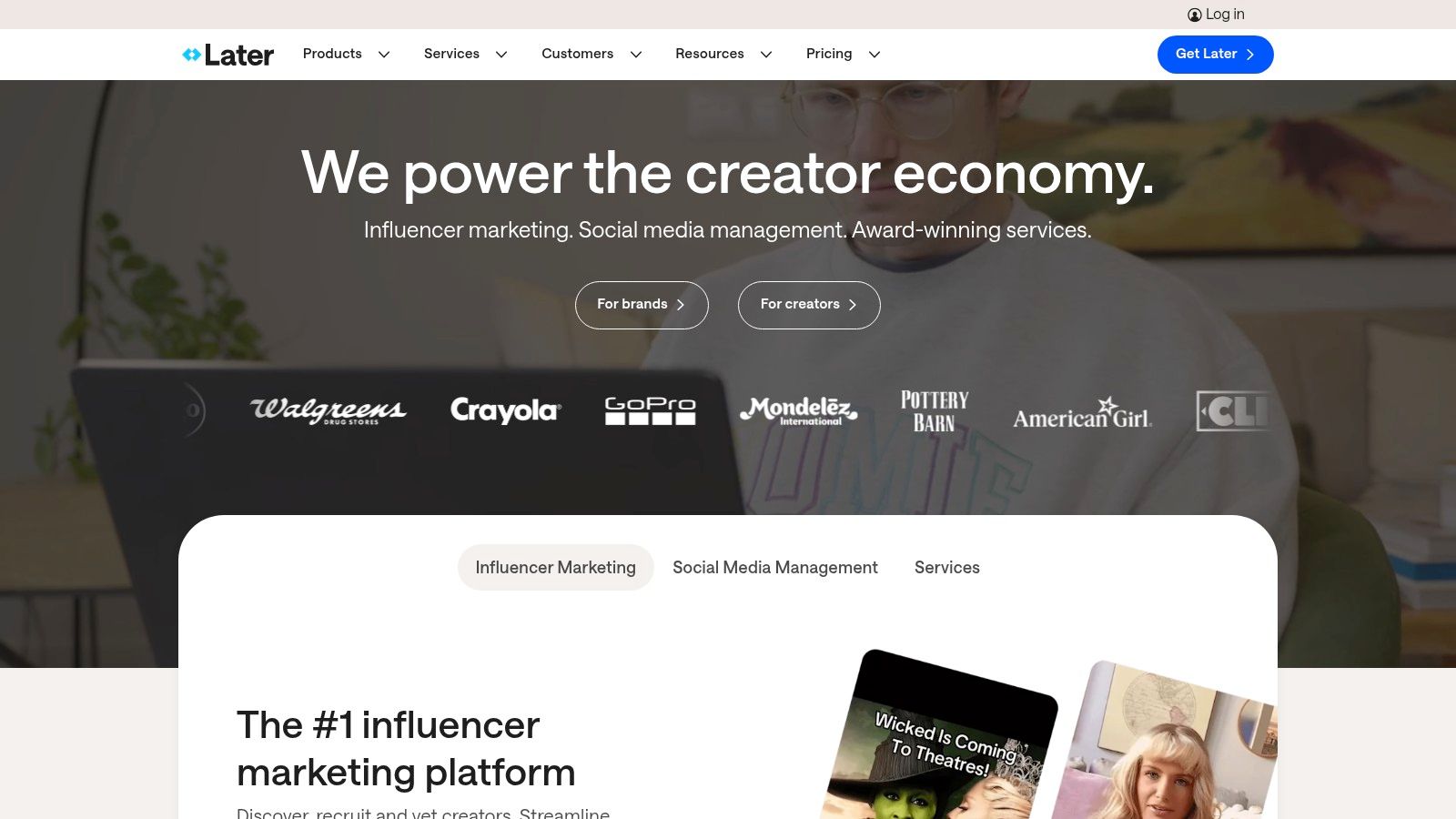
Later’s primary focus on visual platforms makes it a highly effective content distribution platform for businesses that rely heavily on image and video-based content. For example, a fashion boutique can use Later to plan and schedule their Instagram feed weeks in advance, ensuring a cohesive aesthetic and consistent posting schedule. They can visually preview their grid, drag-and-drop posts to rearrange them, and write captions all within the platform's intuitive interface. Similarly, a food blogger can leverage Later's Pinterest integration to distribute their recipe visuals and drive traffic back to their website. The platform's ability to handle multiple visual platforms simultaneously streamlines the content distribution process, saving valuable time and resources.
One of Later's key strengths is its visual content calendar and drag-and-drop scheduling interface. This feature provides a clear overview of scheduled content, making it easy to visualize the overall social media strategy. The drag-and-drop functionality simplifies the scheduling process, allowing users to quickly adjust posting times and optimize content flow. Furthermore, Later’s Instagram-specific features, including Stories and Reels scheduling, offer granular control over Instagram content distribution. Businesses can pre-plan their Stories and Reels, incorporating relevant hashtags and links to maximize engagement and reach. Later also simplifies user-generated content management by allowing users to collect, organize, and request rights to user-generated content, providing valuable social proof and fostering community engagement. The platform's link-in-bio landing page builder provides a central hub to direct traffic from Instagram, consolidating multiple links and driving traffic to various online destinations.
Later offers a range of pricing plans, including a free plan with limited features and paid plans with increasing functionalities. Paid plans offer access to more social sets, scheduled posts, additional users, and advanced analytics. Specific pricing details are available on their website. In terms of technical requirements, Later is a cloud-based platform accessible through a web browser or mobile app, making it compatible with most operating systems.
Compared to other content distribution platforms like Hootsuite or Buffer, Later's visual focus and Instagram-specific features make it a more suitable choice for businesses that prioritize visual content. While platforms like Hootsuite offer a wider range of platform integrations and more robust analytics, Later’s streamlined visual interface and ease of use make it a strong contender, especially for beginners. Buffer, while similar in its user-friendly approach, doesn’t offer the same level of Instagram-specific features that Later provides.
To effectively implement Later, begin by connecting your social media accounts and setting up your visual content calendar. Take advantage of the visual planner to map out your content strategy and ensure a consistent brand aesthetic. Utilize the hashtag suggestion tool to optimize reach and discoverability. Explore Later’s analytics to track performance and refine your content distribution strategy over time.
While Later excels in visual planning and Instagram features, it’s important to note its limitations. Advanced analytics capabilities are somewhat limited compared to other platforms, and platform integrations are fewer. Team collaboration features are also relatively basic. Customer support is primarily provided through chat, which may not be ideal for all users.
However, its user-friendly interface, robust Instagram features, and affordable pricing make Later a valuable content distribution platform for businesses seeking to elevate their visual storytelling on social media. For businesses and individuals focused on visual content, particularly on Instagram, Later's intuitive interface and specialized features offer a powerful solution for streamlining content distribution and maximizing impact. You can explore Later and its features further at https://later.com.
10. Mailchimp
Mailchimp is a well-established name in the email marketing world, but it's evolved into a much more comprehensive content distribution platform. While email remains its core strength, Mailchimp now offers a range of features that allow businesses to distribute content across multiple channels, including social media, paid ads, and landing pages. This makes it a versatile solution for businesses looking to streamline their content distribution efforts and manage their marketing from a central hub. It's especially valuable for those prioritizing email marketing as a primary content distribution strategy while exploring other avenues. This multi-channel approach allows for greater reach and engagement, ultimately contributing to a more effective content strategy.
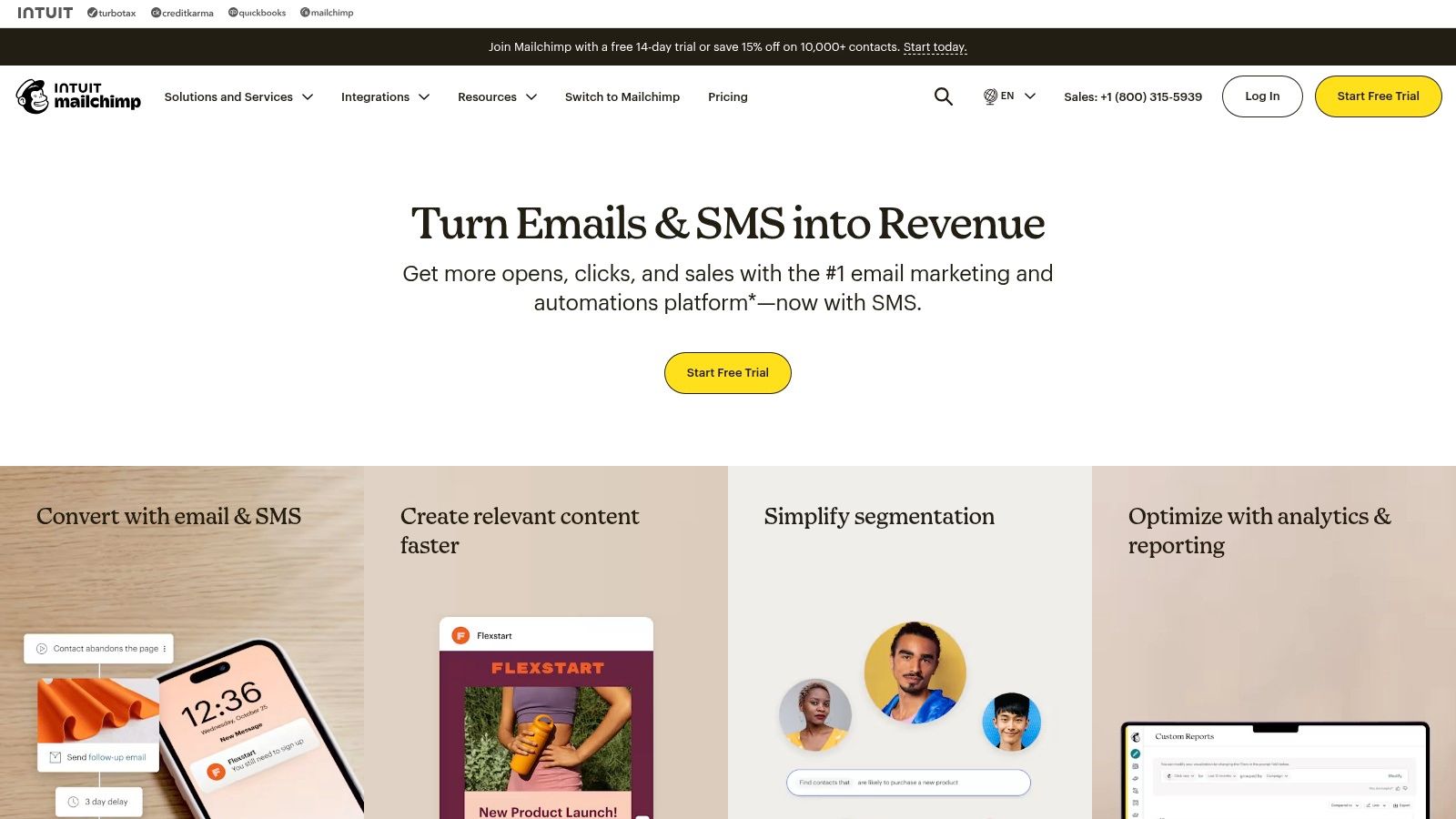
One of Mailchimp's key strengths as a content distribution platform lies in its robust email marketing capabilities. Beyond basic email blasts, Mailchimp empowers users to create sophisticated automated email sequences triggered by specific user actions or events. Imagine a welcome series for new subscribers, abandoned cart reminders for e-commerce stores, or personalized product recommendations based on past purchases. These targeted email campaigns deliver the right content to the right people at the right time, nurturing leads and driving conversions. Its drag-and-drop editor simplifies the process of creating visually appealing emails, even for those without coding experience.
Mailchimp also goes beyond email with its multi-channel functionalities. You can create and schedule social media posts across various platforms directly within Mailchimp, ensuring consistent brand messaging and saving valuable time. The platform also allows you to run targeted ad campaigns on platforms like Google and Facebook, extending your content's reach to a wider audience. Furthermore, Mailchimp's landing page builder enables you to create dedicated pages for specific campaigns, optimizing conversion rates and capturing leads. This integrated approach makes Mailchimp a powerful content distribution platform for reaching a broader audience and managing various marketing efforts within a unified system.
For businesses operating in the e-commerce space, Mailchimp offers seamless integrations with popular platforms like Shopify and WooCommerce. This allows for automated product updates, personalized product recommendations, and abandoned cart recovery emails, driving sales and boosting revenue. This feature is particularly beneficial for small business owners and digital marketers aiming to enhance their e-commerce strategies and improve customer retention.
A significant advantage of Mailchimp is its generous free tier, making it accessible to startups and small businesses with limited budgets. This free plan allows you to manage up to 2,000 contacts and send up to 10,000 emails per month, providing ample opportunity to experiment with the platform and build an initial audience. However, as your contact list grows, the pricing increases significantly, which can be a limiting factor for rapidly scaling businesses. While the free tier offers essential features, more advanced functionalities like A/B testing and multivariate testing require higher-tier plans.
Mailchimp's user-friendly interface makes it easy to navigate and manage campaigns. However, some users find the interface cluttered, particularly as they access more advanced features. While the platform boasts excellent email deliverability rates, ensuring your content reaches the intended recipients' inboxes, its limited phone support can be a drawback for users requiring immediate assistance. Compared to other content distribution platforms like HubSpot or Marketo, Mailchimp offers a more simplified and streamlined approach, focusing primarily on email marketing while providing additional multi-channel functionalities. While it may not offer the same level of depth in certain areas like CRM integration, it excels in its ease of use and affordability for smaller businesses.
Implementing Mailchimp is relatively straightforward. Simply create an account, import your contact list, design your email templates, and set up your automation workflows. To maximize your results with Mailchimp, segment your audience based on demographics, behavior, and preferences to deliver more targeted and personalized content. Leverage A/B testing to optimize your email subject lines, content, and call-to-actions for improved engagement and conversion rates. Regularly analyze your campaign performance metrics to identify areas for improvement and refine your content distribution strategy. This iterative process is crucial for optimizing your campaigns and maximizing their effectiveness.
For small business owners, digital marketers, social media managers, customer success teams, and creative agencies seeking a user-friendly and affordable content distribution platform with robust email marketing capabilities, Mailchimp is a strong contender. While its pricing structure can be a consideration for larger lists, the platform's multi-channel functionalities, generous free tier, and ease of use make it a valuable tool for businesses looking to streamline their content distribution efforts and connect with their target audience effectively. The website, located at https://mailchimp.com, offers further details and resources.
Top 10 Content Distribution Platforms Comparison
| Platform | Core Features & Capabilities | User Experience & Quality | Value & Pricing | Target Audience 👥 | Unique Selling Points ✨ |
|---|---|---|---|---|---|
| 🏆 EndorseFlow | AI-powered video testimonial collection; unified social scheduler; Zapier integration | ★★★★☆ Ease of use; 85% video completion rate | 💰 Free tier + 14-day trial; scalable plans | Small biz, marketers, agencies, customer success teams | ✨ Testimonial-to-social automation; ROI calculator; cross-posts viral videos |
| ContentKing | Real-time SEO monitoring; technical SEO audits | ★★★★ User-friendly; actionable SEO insights | 💰 Higher pricing | SEO pros, webmasters | ✨ Continuous content monitoring; instant SEO alerts |
| Outbrain | Native ads; audience targeting; real-time analytics | ★★★★ Strong analytics; effective traffic driver | 💰 Expensive for small biz | Publishers, advertisers | ✨ Premium publisher network; ML-driven content recommendations |
| Taboola | AI content recommendations; monetization tools | ★★★★ Sophisticated AI engine; reporting | 💰 High minimum spends | Publishers, brands | ✨ Large premium network; strong monetization |
| CoSchedule | Marketing calendar; social scheduling; project mgmt | ★★★★ Intuitive calendar; strong collaboration | 💰 Pricey for small teams | Marketing teams, agencies | ✨ Project mgmt + content planning in one platform |
| Hootsuite | Social scheduling; monitoring; analytics; team tools | ★★★★ Robust analytics; strong integrations | 💰 Mid to high pricing | Enterprises, marketing teams | ✨ Extensive social listening & collaboration |
| Buffer | Scheduling; publishing; analytics | ★★★★ Very user-friendly; good mobile | 💰 Affordable; simple tiers | Small biz, creators | ✨ Clean UI; affordable; team permissions |
| Sprout Social | Advanced analytics; social CRM; listening | ★★★★ Comprehensive; enterprise-grade | 💰 Premium pricing | Large orgs, agencies | ✨ Social CRM; competitor analysis; top-tier support |
| Later | Visual content calendar; Instagram features | ★★★★ Great for visual planning & IG | 💰 Good free plan; limited integrations | Lifestyle brands, creators | ✨ Instagram Stories/Reels scheduling; link-in-bio builder |
| Mailchimp | Email marketing automation; segmentation; multi-channel | ★★★★ Strong automation; easy editor | 💰 Generous free tier; costly at scale | SMBs, e-commerce, marketers | ✨ All-in-one email + multi-channel marketing |
Amplify Your Impact: Choosing the Right Content Distribution Platform
Choosing the right content distribution platform is crucial for maximizing your content's reach and impact. From social media scheduling with tools like Hootsuite, Buffer, Sprout Social, and Later, to native advertising with platforms like Outbrain and Taboola, and email marketing with stalwarts like Mailchimp, the options we’ve explored offer a diverse range of functionalities to suit various content distribution strategies. Content optimization platforms like ContentKing play a vital role in ensuring your content is discoverable, while editorial calendar tools like CoSchedule help streamline your content creation and distribution workflow. Remember to consider your budget, technical skills, and specific marketing goals when selecting the best content distribution platform for your needs. Factors like team size, content formats, and target audience should also inform your decision. Implementing these tools effectively requires careful planning and integration with your existing marketing processes.
A key takeaway is that a strategic approach to content distribution is no longer optional, but essential for success in today’s competitive digital landscape. By understanding the strengths of each content distribution platform and aligning them with your specific requirements, you can effectively target your desired audience, boost brand visibility, and ultimately drive significant business growth. This meticulous selection process, combined with a well-defined content strategy, will empower you to achieve your marketing objectives in 2025 and beyond.
Looking for a streamlined way to amplify your content's reach through employee advocacy? EndorseFlow makes it easy to transform your team into powerful brand ambassadors, organically extending your content distribution across their networks. Discover how EndorseFlow can elevate your content distribution strategy by visiting EndorseFlow.